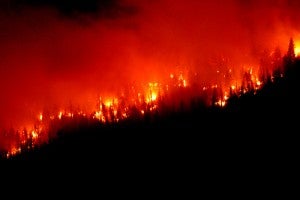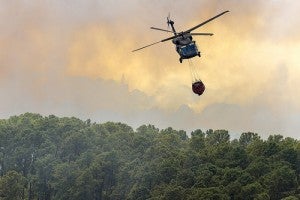
On June 22, the Forest Service announced that there is a record 66 million dead trees in the southern Sierra Nevada. Credit: Kings Canyon National Park, California (license)
Scientists from the U.S. Forest Service estimate that as many as 26 million trees have died in the Sierra Nevada over the last eight months, creating a landscape at risk for massive wildfires.
Sierra Nevada forests require fire to maintain ecological integrity and periodic fires create patches of complexity that actually enhance biodiversity and ecosystem integrity. But tree mortality at this level creates an immediate risk to human communities and plant communities.
Why are trees dying?
Changes in weather that stress trees or exacerbate other stressors like bark beetle infestations are driving the current wave of tree mortality. Temperatures are increasing at a faster rate at higher elevations and precipitation patterns are changing. Specifically, more precipitation is falling as rain and less as snow, which leads to faster runoff and less percolation into the soil. And despite a relatively wet winter, California is still locked into its fifth year of drought.
These dynamics have been particularly acute in the southern Sierra Nevada, where precipitation continues to be below normal. Tree mortality is highest in the southern part of the range as seen in this map.
So what can we do about this?
- First, we need to get comfortable with fire

Wildfires have become increasingly common throughout the West as temperatures rise and landscapes dry out. Credit: Fire (license)
Fire has always been a force in shaping Sierra Nevada forests and always will be. Fire dynamics will be very different under a changing climate, but eliminating fires altogether is not a practical option.
We should be thinking, instead, about managing Sierra Nevada forests with fire in ways that protect human communities and enhance ecosystem services to the maximum extent possible, given changing trends in weather and climate.
- We need more burning
That’s right: we must combat fire with fire. Strategically thinning and burning forests will help this ecosystem avoid larger, catastrophic fires.
A considerable body of science exists to help managers make intelligent choices about which trees to remove, which to leave, and in which pattern. But thoughtful, science-based management requires investment in strategically thinning and prescribing burning of forests to remove hazardous fuels from the forest.
Smart investment strategies can insure that some portion of the fuel removed from the forest is put to use in generating heat and electricity. For example, Placer County has proposed development of a woody biomass electricity plant to be fed by the bi-products of restoration treatments. More importantly, the Forest Service needs more funds to invest in building resilience in Sierra Nevada forests. Many of these funds are currently diverted to combat wildfires, which does not get at the source of the problem.
- Leave some dead trees
We can’t possibly afford to take all of the dead trees out the Sierra and treat every acre. Standing dead trees and fallen trees, after all, provide tremendous value for many invertebrates, birds and mammals. They are an essential component to any restoration plan.
The trick is to manage the fuel load in a forest to limit high severity fire. Doing so requires the input of highly trained foresters and requires finding the right balance between leaving some dead wood and removing enough to diminish the risk of high severity fire.
- Change how we talk about fire
Not all high severity fire is a “catastrophe.” You will hear talk of catastrophic fire. I have used that term myself in the past. But gaining comfort with fire requires that we get comfortable with the fact that very hot fires will occur throughout the Sierra. They always have.
That being said, the fuel loads present in Sierra forests today are a legacy of forest management decisions over the past 150 years that have left the ecosystem more vulnerable than ever.
We have an obligation to apply human ingenuity and science through smart management choices. One such choice would be to prioritize fuel treatments to minimize high severity fire, particularly in low and mid elevation forests.
- Improve post-fire management

Credit: National Guard (license)
An eminent group of scientists produced a seminal report in 2009 entitled An Ecosystem Management Strategy for Sierran Mixed Conifer Forests. The report helped generate significant consensus on how to manage Sierra forests to mitigate fire risks and promote ecosystem integrity. But no such report has been written about how to manage Sierra forests after fire.
Much research is required, and the science community should assemble itself soon to synthesize the best available science on this issue.
Fire will continue to occur with great intensity and frequency, and I worry that the current fuel load will result in significant high severity fire in the coming fire seasons. Forests managers are hungry for more information on how to help ensure that Sierra forests continue to provide a wide suite of ecosystem services for many years to come, and post-fire management is an essential piece of the solution that is currently lacking.
With these five lessons in mind, I hope that we can adjust fire management practices and cultures so that people looking back 150 years from now can say we changed the way we live with fire for the better.
Related:
The devastation of the Soda Fire, and the seeds of hope for the future >>
After the Rim Fire, the surprising role of salvage logging >>
My quest to balance nature and the agricultural economy >>










2 Comments
Eric – I agree with much of what you say here. But, first, high severity fire is not a catastrophe but the aftermath of these snag forests provides habitat for an array of biodiversity that rivals old growth. So why do we need to limit it when, in fact, there is a deficit of high-severity fire in most western forest regions, including the Sierra? Makes no sense. And what does leaving “some” dead trees mean? Why do we need to take dead trees when in fact the work to date, including in southern CA forests, shows dead trees are NOT a risk to increased fire severity? I can send you the studies if you like. Removing even “some” dead wood has been shown to repeatedly cause more environmental harm than the benefits produced by a high severity fire. Salvage is the worse thing these forests can experience after fire.
You just won’t let this myth go away will you?
http://www.sciencemag.org/news/2015/03/tiny-beetles-don-t-cause-big-fires-study-finds-raising–questiopolicyns